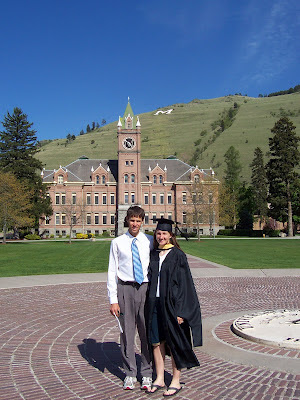(posted by Jayne)
While Isaac was roaming around the western United States working with a commercial beekeeper, I was finishing my masters in Rural Sociology at the University of Montana. As part of my masters program I held an internship at The PEAS (Program in Ecological Agriculture and Society) Farm, which was a partnership with the University's Environmental Studies program and Garden City Harvest, a non-profit that focuses on building community through agriculture.
 The PEAS Farm greenhouse in the distance, located in the Rattlesnake valley in Missoula.
The PEAS Farm greenhouse in the distance, located in the Rattlesnake valley in Missoula.The PEAS Farm offered me the opportunity to learn more about growing vegetables on a larger scale than the backyard garden we had growing up. My sister-in-law Becky and I had the crazy dream of becoming produce farmers, but we had never really seen it done in a tangible way, and didn't know if it would really be possible to make a living this way. The PEAS farm showed us a reasonable scale that could be achieved, and put us in contact with an inspiring professor and farmer, Josh Slotnick. Josh and his wife founded Clark Fork Organics in 1992, and in 1996 he became an Environmental Studies professor at UM and helped to start the PEAS farm.
One of the best parts about working at the PEAS farm was that while we worked in the fields - planting, weeding, watering, and harvesting... Josh would teach. Josh has the gift that so many professors have - being able to explain obscure concepts in such an easily understandable, attainable way. Michael Pollan, Wendell Berry, and Jared Diamond were just a few of the authors often discussed, intermixed with information about crop science, organic farming practices, as well as practical knowledge about how to cook rare vegetables.
 At the PEAS farm I learned how to eat beets, celeriac, and kale. Oh, the kale... it grew so large and never got bitter! This was cool weathered Montana, afterall. And the carrots were so so sweet... the best carrots I have ever tasted. We ate them right out of the field without washing them because they were too good to resist. The PEAS farm grew the carrots, and then took them to a cannery at the Montana State Prison where inmates worked to preserve the food, which was eventually distributed by the Montana Food Bank Network. This was just one of the many great programs the PEAS Farm took part in. Below is a picture of some of my fellow workers taking a break while harvesting carrots. So we didn't work too hard all of the time...
At the PEAS farm I learned how to eat beets, celeriac, and kale. Oh, the kale... it grew so large and never got bitter! This was cool weathered Montana, afterall. And the carrots were so so sweet... the best carrots I have ever tasted. We ate them right out of the field without washing them because they were too good to resist. The PEAS farm grew the carrots, and then took them to a cannery at the Montana State Prison where inmates worked to preserve the food, which was eventually distributed by the Montana Food Bank Network. This was just one of the many great programs the PEAS Farm took part in. Below is a picture of some of my fellow workers taking a break while harvesting carrots. So we didn't work too hard all of the time...
The PEAS Farm had such a profound effect on my life, and I credit my time there for giving me the faith to jump into this Honeyrun Farm project once we returned to Ohio. I still remember clearly a time during my final Fall semester at UM, working at the farm one afternoon, we finished early with our harvesting for the day. We had harvested a pumpkin that was well known for having great seeds for roasting, and we retired to the PEAS Straw Bale Barn to try them out. I was standing on the porch of the barn, looking out over the Rattlesnake Valley, the trees blanketed in brilliant colors of Fall, the soft green mountains surrounding us on all sides, and said to Josh and my fellow workers, "After I leave here, when I think back on my time spent in Montana... this is what I am going to remember the most."
And I was right. Not just the beauty of the area, but everything about the PEAS farm resonates with me as being the right place for me at that point in time. I'm so glad I had the opportunity to work at the PEAS farm, and only hope there could be more programs out there similar to Garden City Harvest in Missoula, MT. Thank-you Josh, for encouraging a new generation of farmers.
 And yes, it is perfectly acceptable to wear flip flops and sneakers to a graduation ceremony in Montana.
And yes, it is perfectly acceptable to wear flip flops and sneakers to a graduation ceremony in Montana.
I ♥ the picture of you sitting in the midst of the field with the landscape behind you 3...the little house looks charming.
ReplyDeleteThanks for reading Marfa! That little house is actually the barn, made using straw bale construction. It had a loft in the top for living quarters (and drying and curing onions and garlic), a simple bathroom and kitchen on the main floor, along with a large gathering room for eating and distributing CSA shares. If you are ever in Montana you should swing by and take a tour of the PEAS Farm. It is a great place!
Delete